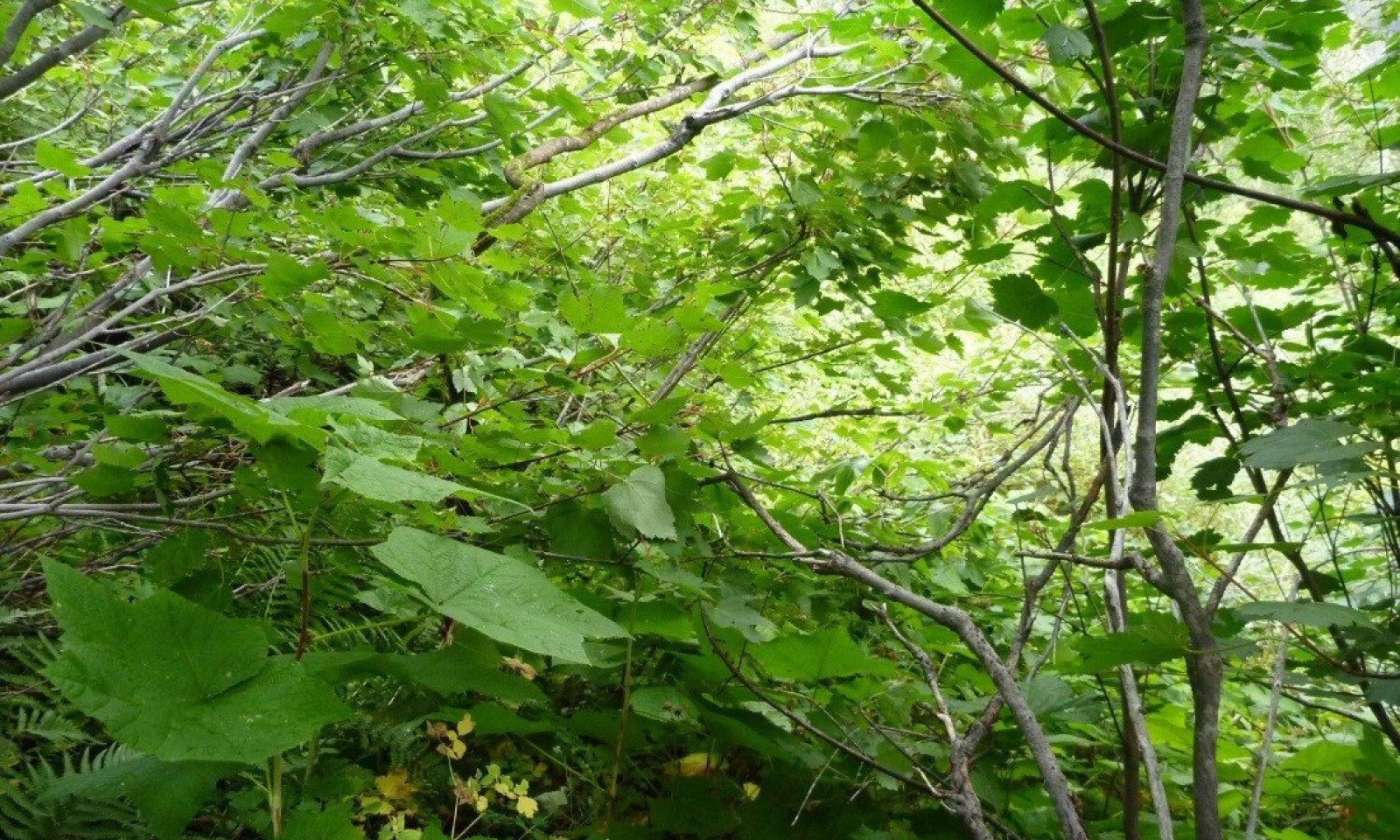
Montane Stable Colluvial Slope Saskatoon serviceberry-common snowberry/Sitka alder/ Rocky mountain maple/thimbleberry/mountain brome-Geyer’s sedge
Circle-spoke model
Scenario model
Current ecosystem state
Select a state
Management practices/drivers
Select a transition or restoration pathway
-
No transition or restoration pathway between the selected states has been described
Target ecosystem state
Select a state
State 1
Reference




Description
This site is defined by the stabilizing nature of the root system of the shrub species and their resprouting capabilities after fire disturbance. The reference community is defined as a mixed composition of serviceberry, snowberry, Sitka alder, Rocky mountain maple and other shrub species. Wood’s rose and chokecherry should appear in low to moderate cover values. The understory is diverse and can range from drier site species with Oregon creeping grape, Geyer’s sedge and bluebunch wheatgrass occurring frequently and in high cover to moister site species including thimbleberry and mountain brome. Though monocultures of one shrub do exist, i.e. Ceonothus after a severe fire, the core concept for this ecological site is a mix of shrubs at all canopy cover layers. Scattered trees can be present including: subalpine fir (Abies lasciocarpa), lodgepole pine (Pinus contorta), Engelmann spruce (Picea engelmannii), ponderosa pine (Pinus ponderosa), quaking aspen (Populus tremuloides), and Douglas fir (Pseudotsuga menziesii). Other shrub species present are redstem ceanothus (Ceanothus sanguineus), snowbrush ceanothus (Ceanothus velutinus), Rocky mountain maple (Acer glabrum), thimbleberry (Rubus parviflorus), oceanspray (Holodiscus discolor), American red raspberry (Rubus idaeus), Scouler’s willow (salix scouleriana), white spirea (Spiraea betulifolia), twinberry honeysuckle (Lonicera involucrata), alderleaf buchthorn (Rhamnus alnifolia), thinleaf huckleberry (Vaccinium membranaceum) and grouse whortleberry (Vaccinium scoparium). Forb species are diverse and occur in low cover individually and include: common yarrow (Achillea millefolium), woodland strawberry (Fragaria vesca), Virginia strawberry (fragaria virginiana), nineleaf biscuitroot (Lomatium triternatum), yellow penstemon (Penstemon confertus) and common cowparsnip (Heracleum maximum). These shrublands are considered to be self-sustaining and not seral to conifer species. The extremely thick shrub cover precludes invasion by conifer species to any large extent.
The disturbance factors for this ecological site are fire, minor avalanche activity, erosional tears, grazing, browsing, animal burrows, animal trails, bear and badger digging and tent caterpillars. The majority of the shrub species occurring in this ecological site respond well to these disturbances through resprouting or extensive seed banking. Ceanothus species can dominate a site after severe fire to the exclusion of other shrub species.
This ecological site is differentiated from its associated site Montane Meadows which is a grassland dominated by rough fescue (Festuca campestris) and Idaho fescue though it may have low cover of the following shrubs: Saskatoon serviceberry (Amelanchier alnifolia), shrubby cinquefoil (Dasiphora fruticosa), thimbleberry and kinnickinick (Arctostaphylos uva-ursi).
Submodel
Model keys
Briefcase
Add ecological sites and Major Land Resource Areas to your briefcase by clicking on the briefcase (![]() ) icon wherever it occurs. Drag and drop items to reorder. Cookies are used to store briefcase items between browsing sessions. Because of this, the number of items that can be added to your briefcase is limited, and briefcase items added on one device and browser cannot be accessed from another device or browser. Users who do not wish to place cookies on their devices should not use the briefcase tool. Briefcase cookies serve no other purpose than described here and are deleted whenever browsing history is cleared.
) icon wherever it occurs. Drag and drop items to reorder. Cookies are used to store briefcase items between browsing sessions. Because of this, the number of items that can be added to your briefcase is limited, and briefcase items added on one device and browser cannot be accessed from another device or browser. Users who do not wish to place cookies on their devices should not use the briefcase tool. Briefcase cookies serve no other purpose than described here and are deleted whenever browsing history is cleared.
Ecological sites
Major Land Resource Areas
The Ecosystem Dynamics Interpretive Tool is an information system framework developed by the USDA-ARS Jornada Experimental Range, USDA Natural Resources Conservation Service, and New Mexico State University.
